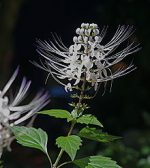 Native to the forest edges of tropical areas in Southeast Asia, this herbaceous perennial shrub is also known as Java tea, and is a member of the deadnettle family, Lamiaceae, that also includes mint, basil, and bee balm. The plants gro up to 40″ tall and have purple tinged stems tinged bearing pairs of narrowly ovate, dark green leaves that are 2-4″ long and deeply veined with coarsely toothed margins. From late summer into autumn, white to light pink flowers appear that are attractive to bees, butterflies and birds. Each flower has a tube-like corolla 1″ long and 2″ long extruded stamens that resemble cat’s whiskers. The plant has been used medicinally to treat many problems including hypertension, inflammation, jaundice, diabetes and problems related to the kidney and bladder. It has been cultivated for tea in Java and Sumatra. The genus name, Orthosiphon, comes from the Greek words othos meaning straight and sipon meaning pipe, and refers to upright tube shape of the flower. The specific epithet, aristatus, is the Latin word meaning having an ear-like structure, perhaps referring to the fact that the petals extend outward like ears.
Native to the forest edges of tropical areas in Southeast Asia, this herbaceous perennial shrub is also known as Java tea, and is a member of the deadnettle family, Lamiaceae, that also includes mint, basil, and bee balm. The plants gro up to 40″ tall and have purple tinged stems tinged bearing pairs of narrowly ovate, dark green leaves that are 2-4″ long and deeply veined with coarsely toothed margins. From late summer into autumn, white to light pink flowers appear that are attractive to bees, butterflies and birds. Each flower has a tube-like corolla 1″ long and 2″ long extruded stamens that resemble cat’s whiskers. The plant has been used medicinally to treat many problems including hypertension, inflammation, jaundice, diabetes and problems related to the kidney and bladder. It has been cultivated for tea in Java and Sumatra. The genus name, Orthosiphon, comes from the Greek words othos meaning straight and sipon meaning pipe, and refers to upright tube shape of the flower. The specific epithet, aristatus, is the Latin word meaning having an ear-like structure, perhaps referring to the fact that the petals extend outward like ears.
Type: Deciduous perennial
Outstanding Characteristic: Medicinal properties
Form: Upright
Growth Rate: Rapid
Bloom: White to light pink with tube like corolla and etxruded stamens from late summer into fall
Size: up to 40″ H x 12″-36″ W
Light: Full sun to partial shade
Soil: Fertile, moderately, consistently, moist, well-drained
Hardiness: Zones 9-12
Care: Apply a high nitrogen fertilizer once in spring and once in summer; cut back after flowering to encourage good regrowth.
Pests and Diseases: None of significance
Propagation: Seed, softwood cutting (will root in water)
Outstanding Selections: unknown
Photo Credit: Wikipedia